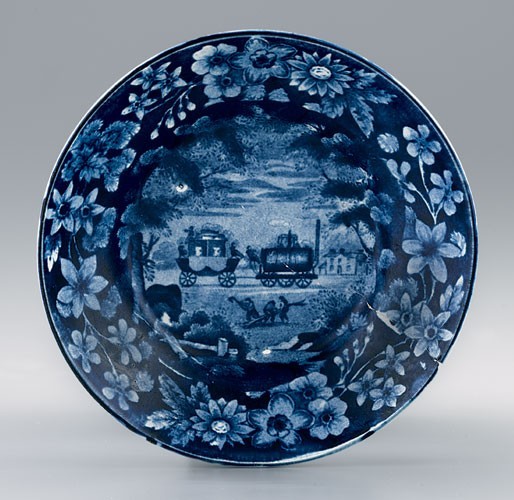
Saucer, Straffordshire, ca. 1820s. Pearlware. D. 5 3/4". (Courtesy, Roger Pomfret; photo, Gavin Ashworth.)
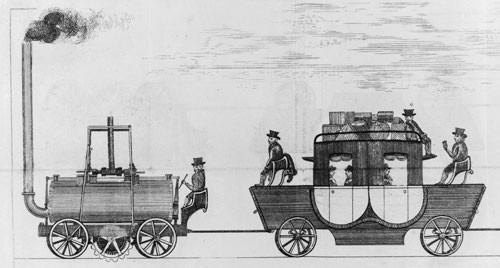
Print from Observations on a General Iron Railway, by Thomas Gray, 5th ed. (London, 1825). Although the pottery engraving represents the locomotive with fair accuracy, the coach is only an approximation, suggesting a second, unrelated print as its source. This would be consistent with the fanciful description attached to the plate illustrated in Arthur Hayden’s Chats on English Earthenware (1909).
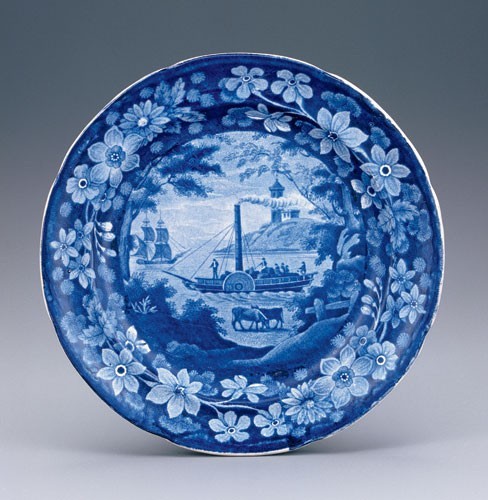
Plate, Staffordshire, ca. 1820s. Pearlware. D. 9 3/4". (Courtesy, Kurt O’Hare; photo, Gavin Ashworth.) The transfer-printed design on this plate depicts a single-funnel steamboat, which is markedly different from the first Fulton steamboat.
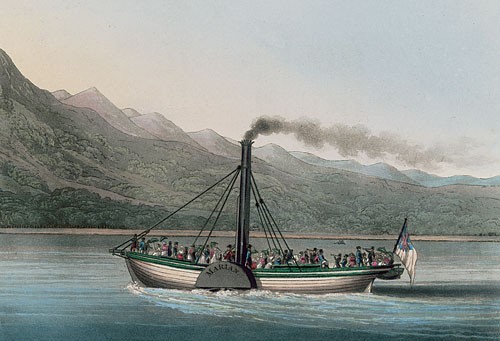
Trip up Loch Lomond, 1825. (Courtesy, Mary Evans Picture Library.) This print by an unknown engraver/publisher depicts the Marian, built by David Napier in 1815, and served as the source for the transfer print depicted in fig. 3.
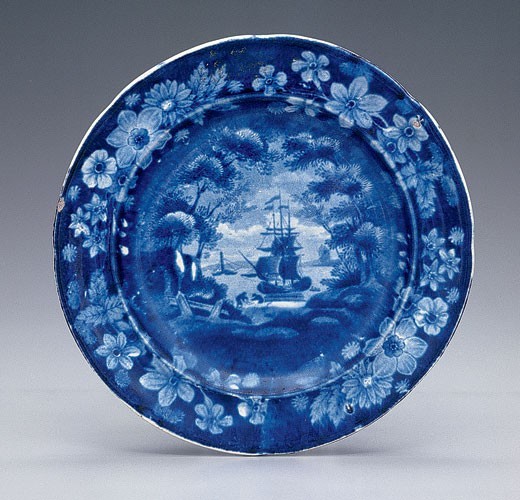
Plate, Staffordshire, ca. 1820s. Pearlware. D. 6 7/8". (Courtesy, Weston H. Palmer, Esq.; photo, Gavin Ashworth.) A three-masted sailing ship—traditionally identified as the Cadmus—is in the foreground and a single-funnel steamer is in the left background.
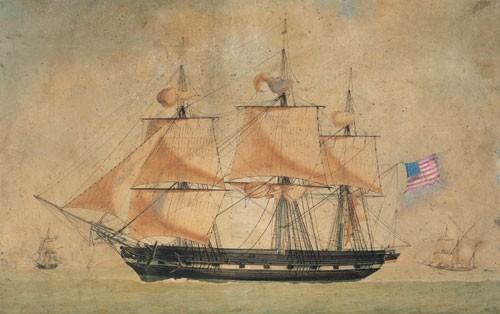
Antoine Roux, Ship Cadmus, 1822. Watercolor. (Courtesy, Peabody Essex Museum; photo, Mark Sexton.)

Exterior base of the saucer illustrated in fig. 1, displaying an impressed open hand mark.
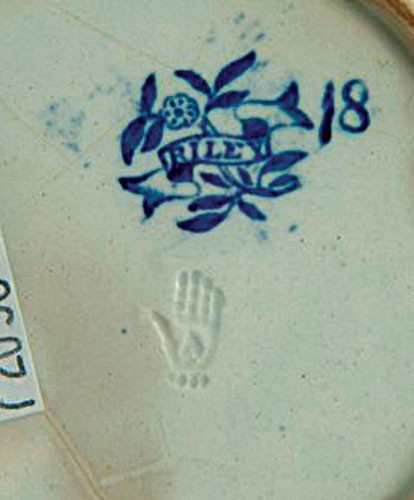
John and Richard Riley, Burslem, Staffordshire, ca. 1820s. Pearlware. Blue printed so-called girl Gardeners pattern with printed “RILEY” flower spray mark and impressed hand. (Courtesy, Dick Henrywood and Dreweatt Neate.)
The identity of the manufacturer and possible source prints of the transport views in the Diorama series of blue transfer-printed earthenware pose interesting challenges. These wares are printed in the very dark blue characteristic of American export pearlware of the 1820s; recorded teawares are of the Grecian/London shape fashionable at that time. Surviving examples, described as scarce by Sam Laidacker more than fifty years ago, are usually found in America.[1]
The common denominator of the series is a border of small stylized flowers. The views depicted fall into two types: English buildings and places; and modes of transport. Coysh and Henrywood have identified at least six English views—a number of which carry a backstamp incorporating the word “DIORAMA” and the subject title within a cartouche—and state that the backstamp does not appear on any of the transport scenes.[2] Laidacker identified the same English views, as well as three basic transport scenes featuring a locomotive, a steamboat, and a three-masted sailing ship.[3] Other surviving transport views appear to be variants of, or perhaps sections of, these three basic views.
Transportation scenes traditionally have been associated with three types of transport in United States history: railway locomotive, with the inception of the Baltimore and Ohio Railroad; steamboat, with the pioneering vessel of Robert Fulton; and sailing ship, with the Cadmus, which brought Lafayette to America on his return visit of 1824.
An English attribution for the railway view (fig. 1) was first suggested by Alvin Wortham, who noted that an almost identical view—suggestive of a common source print—appeared on a Staffordshire-type plate illustrated in Arthur Hayden’s Chats on English Earthenware (1909) with a German inscription translated as “Steam Coach from London to Bristol.”[4] The source print was not identified, but on the evidence of Wortham’s research Laidacker included the series in Anglo-American China (1951), classifying it as “other than American Views.”
The details of the locomotive are engraved with suffcient precision to reveal two distinctive features: the vertical placing of the cylinders, partly inset within the boiler; and the differing alignment of the central wheel of the three under the boiler. As shown more clearly in the source print (fig. 2), the central wheel is cogged, designed to engage with a rack fixed to one side of the railroad. These features are specific to the Blenkinsop/ Murray rack locomotives that commenced operation on the Middleton Colliery Railway near Leeds in 1812. The anachronistic and, at first glance, inexplicable feature of the view is the passenger coach. The rack locomotives of this design had a very low speed capability and were never intended or used for passenger traffic. Furthermore, it is believed that the Stockton and Darlington Railway, not opened until 1825, was the only line on which carriages of this stagecoach form were ever employed.
The second transport view in the series is of a single-funnel steamboat (fig. 3). Dated 1825, the print providing the inspiration for this view has been identified as A Trip up Loch Lomond in the steamer Marian, built by David Napier in 1815 (fig. 4). The outline of the vessel has been followed fairly closely by the pottery engraver, although there are differences: additional features have been introduced, and the numerous passengers have been effaced.
The third transport scene illustrates a three-masted sailing ship (traditionally regarded, as mentioned above, as the Cadmus) with a single-funnel steamer in the left background (fig. 5). Larsen notes that a watercolor of the actual vessel in the collection of the Peabody Museum of Salem, Massachusetts (fig. 6), shows the ship to have been a three-masted merchantman, and that the Diorama engraving may bear greater resemblance to the original than did versions by other potters such as Enoch Wood.[5] The lack of precision in the detail of the hull and rigging makes identification of the source problematical.
What is clear from the comparisons is that the Staffordshire potter responsible for these transport views was less concerned with presenting an accurate reproduction of the original illustration than with suitably adapting his source to another medium in order to show a picture of greater topical interest.
A question still unanswered is whether the traditional American subject names associated with these Diorama transport scenes were given to them by the potter at the time of manufacture or the importer at the time of sale in order to capitalize on public interest in current events. One piece of evidence relating to the “Baltimore and Ohio Railroad” pattern of Wood and Sons suggests that the former was the case. Matthew Smith, the Baltimore importer, first ordered this pattern by name from the manufacturer in July 1827, some time before steam locomotion was used on the line, and possibly even before construction had begun.[6]
No attribution to a specific manufacturer has been made for the series, but emerging evidence points to the possibility that the manufacturer was the firm of John and Richard Riley, in Burslem. The saucer illustrated in figure 1 is impressed on the reverse with an open hand mark (fig. 7). The rarity of the impressed hand makes it unlikely that it was intended as a workman’s mark. Three reported examples of the hand in conjunction with Riley manufacturer’s backstamps provide support for the argument that it represents a manufacturer’s rebus of the Riley factory. The shape of the hand is very distinctive and has not been noted in any other context.
More than twenty years ago the Friends of Blue Bulletin[7] noted that a plate printed with the well-known Dromedary pattern bore an impressed hand in addition to the standard backstamp of “Riley’s Semi-China” on an oval strap buckle. The further examples are items sold at auction in recent years. First, a cup and saucer in the “Girl Gardeners” pattern—the saucer bearing the printed Riley flower-spray backstamp as well as the impressed hand—were sold on March 19, 2003 (fig. 8).[8] Second, a plate in the Large Scroll Border series bearing the maker’s name and title of the view, “Holywell Cottage, Cavan,” in conjunction with the impressed hand was sold on September 19, 2003.[9]
Additional sightings of the hand mark are needed in order to come to any firm conclusion, but two other details of the Riley factory are consistent with the possibility of such an attribution: the firm is known to have had a substantial American trade;[10] and the dating of the wares to the late 1820s on the grounds of style and publication of source prints coincides with its later working period prior to its 1828 closure.
A cautionary note needs to be added. While the printed “DIORAMA” backstamp has not been recorded on any of the transport views, there also has been no report of the impressed hand appearing in conjunction with this backstamp. The discovery of additional pieces might establish whether more than one factory is responsible for what currently is regarded as a single series.
ACKNOWLEDGMENTS
My thanks go to D. W. Hopkin, head of the archive collection of The National Railway Museum, York, for his assistance in identifying the source print for the Blenkinsop/Murray locomotive, for providing figure 2, and for help on other points; to Peter Hyland, for valued discussions while researching this article and for his comments and suggestions on the draft; and to the editors of Ceramics in America, for invaluable assistance in obtaining the illustrations.
Roger Pomfret, Former Chairman, Northern Ceramic Society; drpomfret@ supanet.com
Sam Laidacker, Anglo-American China, Part II: During the Period from 1815 to 1860 (Bristol, Penn.: Privately published, 1951).
A. W. Coysh and R. K. Henrywood, Dictionary of Blue and White Printed Pottery, 1780–1880 (Woodbridge, Suffolk, Eng.: Antique Collectors’ Club, 1982), p. 108.
Laidacker, Anglo-American China, p. 111.
Alvin Wortham, “Staffordshire and the Baltimore & Ohio,” American Collector (December 1939): 463.
Ellouise Baker Larsen, American Historical Views on Staffordshire China, 3rd ed. (New York: Dover Publications, 1975), p, 236.
Matthew Smith Letter Book, Collection of the Historical Society of Maryland. It is thought that the views depicted on the Wood wares are actually of the Hetton Collier Tramway, in England.
Friends of Blue Bulletin 38 (winter 1982–1983): 12.
Sale, Dreweatt Neat, Donnington Priory, England, September 19, 2003, lot 284.
Sale, Dreweatt Neat, Donnington Priory, England, September 19, 2003, lot 138.
“. . . a most excellent assortment of dark blue, printed, painted and other descriptions of earthenware, suited for the American markets, in which markets the deceased carried on extensive dealings.” Staffordshire Advertiser, February 21, 1829, Riley factory sale notice.
